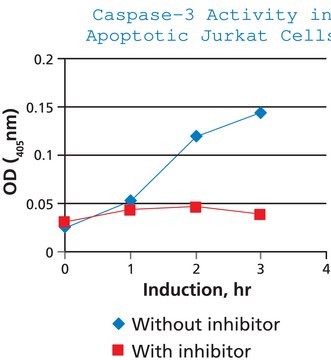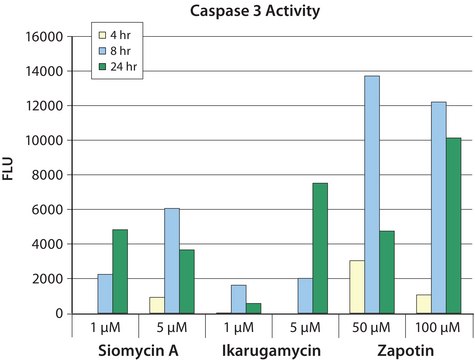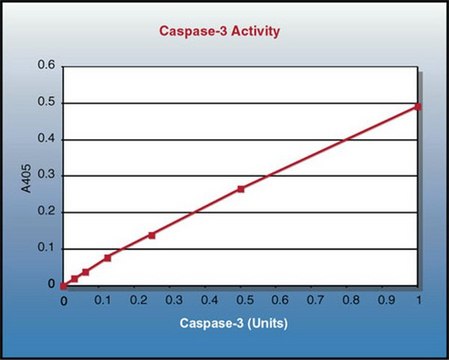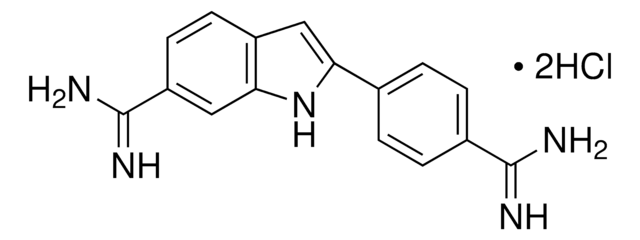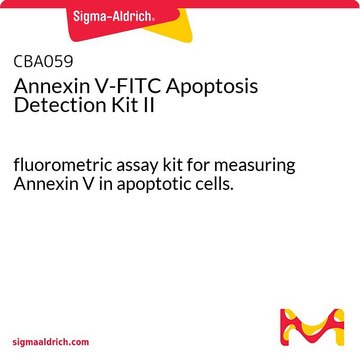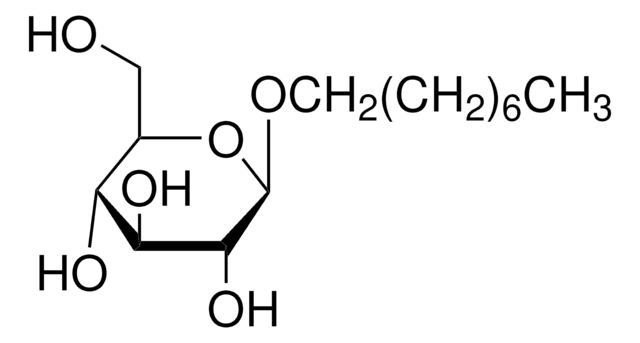推荐产品
用途
sufficient for 96 tests
质量水平
种属反应性(根据同源性预测)
mammals
包装
pkg of 1 96-well plate(s)
制造商/商品名称
Calbiochem®
储存条件
OK to freeze
avoid repeated freeze/thaw cycles
输入
sample type cell extract(s)
检测方法
colorimetric
fluorometric
储存温度
−70°C
一般描述
A convenient assay kit useful for measuring the caspase-3 and caspase-3-like activities in cell extracts using either a colorimetric or fluorometric substrate. Provided in a convenient 96-well format with all reagents necessary for preparing cell extracts, measuring caspase activity and calibrating the assay. In addition, caspase-3 is included for use as a positive control, for testing cell extracts for endogenous inhibitors, or for comparing effects of exogenous inhibitors on cellular activity versus the activity of the purified enzyme.
Caspase-3 (also known as CPP32, apopain, and Yama), a member of the interleukin-1β converting enzyme (ICE) family of cysteine proteases, is composed of 17 and 12 kDa subunits derived from a common proenzyme, pro-caspase-3. It is activated during apoptotic signaling events by upstream proteases including caspase-6, caspase-8 (FLICE), and cytotoxic T-cell-derived granzyme B. Caspase-3 is one of the principal caspases found in apoptotic cells. Targets of caspase-3 cleavage include poly(ADP-ribose) polymerase (PARP), nuclear lamins, gelsolin, and others. Caspase-3 is a potential therapeutic target.
特异性
A broad range of species
组分
Human Recombinant Caspase-3, Cell Lysis Buffer, a DEVD-pNA Colorimetric Substrate, Ac-DEVD-AMC Fluorometric Substrate, Calibration Standard (p-Nitroaniline), AMC Calibration Standard, an Inhibitor, Assay Buffer, one half-volume 96-Well Plate, and a user protocol.
警告
Toxicity: Multiple Toxicity Values, refer to MSDS (O)
产品规格
Assay Time: 2.5-3 h
制备说明
Preparation of Cell Extracts1. Grow cell cultures and induce apoptosis as desired using an appropriate agent. Appropriate controls may include untreated cells, cells treated with an inactive chemical analog of the apoptosis inducer or simply the "time-zero" sample from an apoptosis induction time course. The number of cells required for an experiment must be determined by the user. A sufficient quantity is needed to assay caspase-3 activity, plus additional material to determine protein concentration (as needed).As a guide, here is an example of data obtained with U937 cells:• Protein concentration = 1 - 3 mg/ml [cell density (at lysis) = ~2 x 107 cells/ml]• 10 µl assay sample = 10-30 µg protein (or ~2 x 105 cells)• DEVD-pNA cleavage assays: 10 ml samples; 37°C; A405 after 30 min. - control cells = 0.004, apoptotic cells = 0.22.It is desirable to have enough extract to perform duplicate assays, with and without an inhibitor-treated control and determine protein concentration. Thus, for U937 cells, a minimum of 106 cells in 50 µl for each test condition is suggested. Other cell types may have other requirements.2. Count cells and harvest by centrifugation (e.g.: 1000 x g, 4°C, 10 min). Wash cells once with phosphate buffered saline (PBS). If the cells have been treated with a reagent that may interfere with the subsequent caspase assay (e.g. a potential caspase inhibitor), it may be desirable to wash cells more extensively prior to lysis.3. Resuspend cells to desired concentration (e.g.: 2 x 107/ml) with ice-cold Cell Lysis Buffer. Incubate for 5 min on ice. If cell lysis is incomplete, additional detergent may be added to the Cell Lysis Buffer to assist membrane solubilization/destabilization. Addition of TWEEN®-20 detergent (Cat. No. 655205 or 655206), NP-40 (Cat. No. 492015 or 492017), or TRITON X-100 detergent (Cat. No. 648462 or 648463) to a final concentration of 0.1% is compatible with the subsequent caspase assay.4. Centrifuge at 10,000 x g, 10 min at 4°C.5. Save supernatant (cytosol) and hold on ice bath until use. Alternatively, the extracts may be quickly frozen and stored at -70°C for later use. For highest stability, store all reagents at -70°C. Store the plate at room temperature. Caspase-3 must be handled with particular care at room temperature in order to retain its maximal enzymatic activity. Thaw it quickly in a water bath or by rubbing between fingers, then immediately store on an ice bath. Any unused enzyme should be quickly refrozen at -70°C. To minimize degradation and loss of enzyme activity, aliquot Caspase-3 into several tubes and store at -70°C.
储存及稳定性
Upon arrival store the 1/2 volume plate at room temperature and the remaining components of the kit at -70°C.
分析说明
1. Plot data as A405 or arbitrary fluorescence units (AFU) versus time for each sample.2. For each sample, determine the length of the initial time period over which the plot of absorbance (or AFU) vs. time remains linear, and there is sufficient change in absorbance (or change in AFU) to obtain an accurate slope. The initial substrate concentration (200 µM DEVD-pNA) is saturating. For many samples the rate of DEVD-pNA cleavage will remain constant for at least 2 h. Highly active samples, however, can reduce the substrate concentration to sub-saturating levels in substantially less time. In such cases, choose data from the earlier, linear portion of the time course for use in the slope calculation of Step 3. (For an example, see the "Etop.-4" data in Fig. 2). Since the AMC substrate is used at a sub-saturating concentration (30 µM), extra care must be taken in choosing data that lies within the linear portion of the reaction progress curve.3. Obtain the slope of the line, fitted to the linear portion of the data, using an appropriate linear regression program.4. Average the slopes of replicate samples.DATA ANAYLSIS (in terms of substrate conversion)5. If the blank has a significant slope, subtract this number from all samples. Under normal conditions this will not be necessary since the slope will be nearly zero.6. Specific Activity Calculationsa) To normalize activities with respect to cell number, divide the values calculated in step 6 by the number of cells suspended in 10 µl of lysis buffer. (see Experimental Methods, steps 1-3):Specific Activity (pmol/min/number of cells) = activity (pmol/min)/number of cells per wellb) To calculate specific activities with respect to total protein, determine the protein content of each cell extract. Divide activities by the protein content of the corresponding sample (see Figures 2 and 3):Specific Activity = pmol/min/mg proteinNote: The cell lysis buffer is compatible with Coomassie dye binding (Bradford) and bicinchoninic acid (BCA) based protein assays under appropriate conditions. For the BCA assay, cell extract samples must be diluted ≥10-fold in water. Increased backgrounds may be exhibited with the BCA assays due to the increased DTT concentration. Cell extracts diluted >10-fold with water are considered compatible. Be sure to use cell lysis buffer in the standards and maintain equal amounts in all samples.Note regarding AMC calibration standard: The exact AMC concentration range that will be useful for preparing a standard curve will vary depending on the fluorimeter model, the gain setting, and the exact excitation and emission wavelengths used. The AMC standard, as provided (30 µM), may yield off-scale readings in some cases. We recommend diluting some of the standard to a relatively low concentration with Assay Buffer (0.5 or 1.0 µM) and then measuring the fluorescence of 100 µl. The estimate of AFU/µM obtained with this measurement, together with the observed range of values obtained in the enzyme assays, can then be used to plan an appropriate series of dilutions for a standard curve.
其他说明
Due to the nature of the Hazardous Materials in this shipment, additional shipping charges may be applied to your order. Certain sizes may be exempt from the additional hazardous materials shipping charges. Please contact your local sales office for more information regarding these charges.
Thornberry, N.A., and Lazebnik, Y. 1998. Science 281, 1312.
Faleiro, L., et al. 1997. EMBO J.16, 2271.
Kothakota, S., et al. 1997. Science278, 294.
Nicholson, D.W. 1996. Nat. Biotechnol. 14, 297.
Schlegel, J., et al. 1996. J. Biol. Chem. 271, 1841.
Srinivasula, S.M., et al. 1996. Proc. Natl. Acad. Sci. USA 93, 14486.
Nicholson, D.W., et al. 1995. Nature 376, 37.
Tewari, M., et al. 1995. Cell 81, 801.
Fernandes-Alnemi, T., et al. 1994. J.Biol. Chem.269, 30761.
Faleiro, L., et al. 1997. EMBO J.16, 2271.
Kothakota, S., et al. 1997. Science278, 294.
Nicholson, D.W. 1996. Nat. Biotechnol. 14, 297.
Schlegel, J., et al. 1996. J. Biol. Chem. 271, 1841.
Srinivasula, S.M., et al. 1996. Proc. Natl. Acad. Sci. USA 93, 14486.
Nicholson, D.W., et al. 1995. Nature 376, 37.
Tewari, M., et al. 1995. Cell 81, 801.
Fernandes-Alnemi, T., et al. 1994. J.Biol. Chem.269, 30761.
法律信息
CALBIOCHEM is a registered trademark of Merck KGaA, Darmstadt, Germany
TWEEN is a registered trademark of Croda International PLC
储存分类代码
12 - Non Combustible Liquids
闪点(°F)
Not applicable
闪点(°C)
Not applicable
Yu-I Li et al.
Life sciences, 83(15-16), 557-562 (2008-09-03)
Tanshinone IIA is an important ingredient in the herb danshen (Salvia miltiorrhiza), which has been used to treat cardiovascular diseases such as atherosclerosis and angina for hundreds of years in China. There are numerous reports that TIIA has anti-oxidant properties
S Shastry et al.
Kidney international, 71(4), 304-311 (2006-12-07)
Hyperhomocysteinemia is prevalent among patients with chronic kidney disease (CKD) and has been linked to progressive kidney and vascular diseases. Increased glomerular mesangial cell (MC) turnover, including proliferation and apoptosis, is a hallmark of CKD. Activation of p38-mitogen-activated protein kinase
Ravi K Gutti et al.
The Journal of biological chemistry, 283(25), 17055-17064 (2008-04-24)
Gonadotropin-regulated testicular helicase (GRTH)/DDX25 is an essential post-transcriptional regulator of spermatogenesis. In GRTH null mice severe apoptosis was observed in spermatocytes entering the metaphase of meiosis. Pro- and anti-apoptotic factors were found to be under GRTH regulation in comparative studies
Tania Marchbank et al.
The British journal of nutrition, 105(9), 1303-1310 (2011-01-29)
Cordyceps sinensis (CS) is a traditional Chinese medicine and health food used to support many organ systems. It is commercially produced by cultivation in a liquid medium or on a solid (grain/potato) phase. We tested the effects of hot water
Tania Marchbank et al.
American journal of physiology. Gastrointestinal and liver physiology, 296(4), G697-G703 (2009-01-17)
Colostrum is the first milk produced after birth and is rich in immunoglobulins and bioactive molecules. We examined whether human colostrum and milk contained pancreatic secretory trypsin inhibitor (PSTI), a peptide of potential relevance for mucosal defense and, using in
我们的科学家团队拥有各种研究领域经验,包括生命科学、材料科学、化学合成、色谱、分析及许多其他领域.
联系技术服务部门